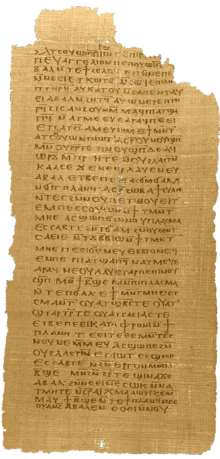Gospel of truth
The Gospel of Truth ( Evangelium Veritatis , abbreviated: EvVer or EV) is a Gnostic text in the Coptic language , probably from the 2nd century. It is part of the Nag Hammadi scriptures (Egypt). There it is handed down as the third writing of the 1st Codex (NHC I, 3) and parts of it in Codex XII. Irenaeus of Lyons mentions a gospel of that name. Whether it is the same is open.
Name and genre
The font has no express title; According to ancient custom, the first two words ("The gospel of truth is a joy ...") were taken as the title. In terms of its genre, it is not a gospel , but a preach-like text with instructive and admonishing sections.
Dating
The terms and echoes of the Valentine Gnosis suggest an identification as the "Gospel of truth" mentioned in Irenaeus (Adversus haereses III 1,9). In this case, the text would have been written around AD 150. Some "Jewish Christian remains" (p. 19,9f.) Speak for an earlier origin.
content
- Introduction: origin, place and meaning of the word that emerged from “Heavenly Father” ( p. 16: 31-17: 3)
- Origin of the error from the search of the divine world for “the origin” (for lack of clear knowledge of the Father); Origin of the material world through error (as a substitute for true reality) (p. 17.4-18.3)
- Origin of "insight" (Gnosis) from the Father (p. 18,4)
- Role of the Savior , Revelation of Gnosis as a book
- Consequences of Revelation
- Return to rest in the Father
Important statements
- “The name Gospel means: Here hope is revealed to people. Everyone who searches can find what they are looking for here. ”(P. 17)
- "Error was concerned with power in making a beautiful substitute for true reality: the visible world." (P. 17)
- “Despise error! Because it was created that way, it has no root. It was created in a fog because one could not see the father clearly. "(P. 17)
- “So when you get to know your father, then from then on forgetting will no longer exist. This is the gospel of God that people are looking for. / Jesus Christ revealed it. He is the hidden secret. "(P. 18)
- “But whoever is without insight to the last is a creature of oblivion, and he will perish with oblivion.” (P. 21)
expenditure
- James M. Robinson (Ed.): Nag Hammadi Studies (NHS). Brill, Leiden 1948ff. ISSN 0169-7749 pp. 37-49. (Coptic and English translation)
- Klaus Berger , Christiane Nord: The New Testament and early Christian writings. Frankfurt 1999, pp. 1050-1067. (Introduction and German translation)
- Hans-Josef Klauck : Apokryphe Evangelien , Verlag Katholisches Bibelwerk, Stuttgart 2002, ISBN 3-460-33022-8 , pp. 177-188.
- Uwe-Karsten Plisch: What is not in the Bible. Apocryphal writings of early Christianity. German Bible Society, Stuttgart 2006, ISBN 3-438-06036-1 .
Web links
- English translation by Robert M. Grant , in: Gnosticism , Harper & Brothers: New York 1961.
- Paterson Brown: The Gospel of Truth Annotated Online Edition of the Ecumenical Coptic Project .
- German text in the online archive (together with all other Nag Hammadi writings)
Remarks
- ↑ Klaus Berger , Christiane Nord: The New Testament and early Christian writings. Frankfurt 1999, p. 1050.
- ↑ Klaus Berger, Christiane Nord: The New Testament and early Christian writings . Frankfurt 1999, p. 1050.
